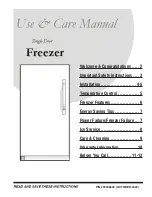
30
Installation, Operation and Service Manual
Thermo Scientific XBF40-MD Series Blast Freezers
Appendix
The controller is powered by 230 V AC but switches 12 V DC to control
the freezer functions. A power supply located on the outside of the relay
enclosure provides the 12 V DC control power. The compressor is activated
by a large 12 V DC contactor that is located inside the relay enclosure. The
evaporator fan and defrost heaters are controlled by two smaller 12 V DC
relays located on the outer surface of the relay enclosure. Both the contactor
and relays are switching 230 V AC that is driving the associated loads.
Refrigerant flow is managed by a thermostatic expansion valve (TXV)
located in the evaporator enclosure, which opens and closes in response to
evaporator outlet temperature.
A solenoid valve between the compressor discharge and suction lines is
opened during defrost in order to provide a balanced-pressure condition for
compressor startup. Due to refrigerant flow through this valve, it is normal
to hear a noticeable whistling noise from the refrigeration deck during the
first few minutes of the defrost cycle.
The suction accumulator is equipped with an internal heat exchanger where
the liquid refrigerant line is passed through the accumulator before being
sent to the expansion device. This subcools the liquid in order to increase
system capacity while also heating the compressor suction stream to reduce
the risk of liquid slugging.
In the event of a sensor failure or loss of communications with the
evaporator or cabinet temperature probe the controller will display a fault
alarm and switch to a modified running mode that permits continued usage
with some features of the unit disabled. A problem with the cabinet probe
will cause the compressor to run constant on, stopping only for defrosts. A
problem with the evaporator probe will cause defrosts to terminate based on
time only. Although continued short-term usage is possible with either of
these faults, the resulting condition is less efficient than normal running and
should be corrected as soon as possible.
Two tanks are connected to the compressor suction line through a capillary
tube. These tanks hold charge at initial startup, and then gradually release it
to the system once the compressor is running. The purpose of this system is
to reduce the starting load on the compressor; once the system is running at
temperature the tanks are effectively inert.
















































